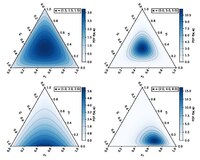
Photo from wikipedia
By using the Q5∗$$ {Q}_5^{\ast } $$-representation of numbers01∋x=βα1x1+∑k=2∞βαkxk∏j=1k−1qαjxj=Δα1xα2x…αkx…Q5∗$$ \left[0,1\right]\ni x={\beta}_{\alpha_1(x)1}+\sum \limits_{k=2}^{\infty}\left({\beta}_{\alpha_k(x)k}\prod \limits_{j=1}^{k-1}{q}_{\alpha_j(x)j}\right)={\Delta}_{\alpha_1(x){\alpha}_2(x)\dots {\alpha}_k(x)\dots}^{Q_5^{\ast }} $$determined by the quinary alphabet A5 ≡ {0, 1, 2, 3, 4} and an infinite stochastic matrix ‖qik‖, i ∈ A5, k ∈ N, with… Click to show full abstract
By using the Q5∗$$ {Q}_5^{\ast } $$-representation of numbers01∋x=βα1x1+∑k=2∞βαkxk∏j=1k−1qαjxj=Δα1xα2x…αkx…Q5∗$$ \left[0,1\right]\ni x={\beta}_{\alpha_1(x)1}+\sum \limits_{k=2}^{\infty}\left({\beta}_{\alpha_k(x)k}\prod \limits_{j=1}^{k-1}{q}_{\alpha_j(x)j}\right)={\Delta}_{\alpha_1(x){\alpha}_2(x)\dots {\alpha}_k(x)\dots}^{Q_5^{\ast }} $$determined by the quinary alphabet A5 ≡ {0, 1, 2, 3, 4} and an infinite stochastic matrix ‖qik‖, i ∈ A5, k ∈ N, with positive elements (q0k + q1k + q2k + q3k + q4k = 1) such that ∏k=1∞maxiqik=0$$ {\prod}_{k=1}^{\infty}\underset{i}{\max}\left\{{q}_{ik}\right\}=0 $$ and β0k = 0, βi + 1, k = βik + qik, i=0,4¯$$ i=\overline{0,4} $$, we define a continuous Cantor-type function by the equalityfΔα1…αk…Q5∗=δα1x1+∑k=2∞δαkxk∑j=1k−1gαjxj≡Δα1x…αkx…G,$$ f\left({\Delta}_{\alpha_1\dots {\alpha}_k\dots}^{Q_5^{\ast }}\right)={\delta}_{\alpha_1(x)1}+\sum \limits_{k=2}^{\infty}\left({\delta}_{\alpha_k(x)k}\sum \limits_{j=1}^{k-1}{g}_{\alpha_j(x)j}\right)\equiv {\Delta}_{\alpha_1(x)\dots {\alpha}_k(x)\dots}^G, $$where δ0n = 0, δ1n=2+εn4$$ {\delta}_{1n}=\frac{2+{\varepsilon}_n}{4} $$, δ2n=24=δ3n$$ {\delta}_{2n}=\frac{2}{4}={\delta}_{3n} $$, and δ4n=2−εn4$$ {\delta}_{4n}=\frac{2-{\varepsilon}_n}{4} $$, i.e., δi + 1, n = δin + gin, n ∈ N, and (εn) is a given sequence of real numbers such that 0 ≤ εn ≤ 1. We prove that this function is well defined and continuous. Moreover, it does not have intervals of monotonicity, except the intervals where it is constant. A criterion of bounded variation of the function is also established. We are especially interested in the problem of level sets of the function and in the topological and metric properties of the images of Cantor-type sets.
Journal Title: Journal of Mathematical Sciences
Year Published: 2019
Link to full text (if available)
Share on Social Media: Sign Up to like & get
recommendations!